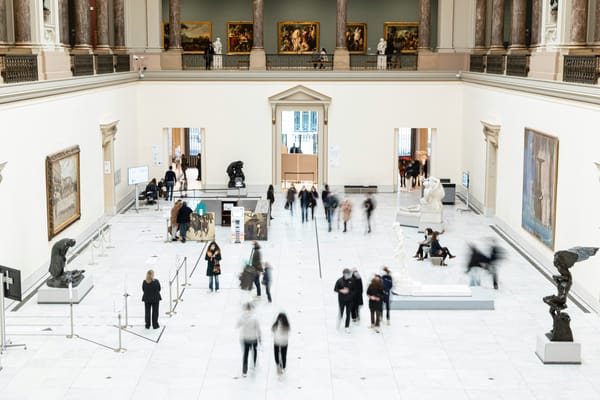Are We Seeing the End of Mega-Galleries?
As small, independent galleries gain prominence in the art world, they challenge the dominance of mega-galleries by offering personalized, community-focused experiences

These intimate venues are redefining how art is experienced, challenging the hegemony of large galleries that have traditionally controlled the market. As the art market evolves, these small galleries are gaining prominence by offering personalized and community-focused experiences, championing local artists, and creating platforms that emphasize artistic integrity over commercial success. But what is driving this shift, and what does it mean for the future of the art world?
For decades, mega-galleries like Gagosian, Hauser & Wirth, and David Zwirner have dominated the global art market. These galleries, with multiple locations worldwide and vast resources, have represented some of the most sought-after artists, often dictating market trends and setting record-breaking sales at auctions. In 2020, the global art market was valued at $50.1 billion, with the top 10 mega-galleries capturing a significant portion of this market share. However, there has been a noticeable shift towards smaller, independent galleries that prioritize a more intimate and accessible approach to art.
This rise can be attributed to several factors. Firstly, there is a growing discontent with the commercialization of art. Many artists and collectors feel that mega-galleries have become too focused on the financial aspect of art, treating it more as a commodity than as a form of expression. Small galleries, on the other hand, offer an alternative by fostering closer relationships between artists, curators, and collectors. These spaces often emphasize the artistic process and the narratives behind the works, providing a more meaningful and engaging experience for visitors.
But is this shift towards smaller galleries a true democratization of the art market, or are we merely witnessing a reconfiguration of exclusivity? As Panu Syrjämäki, Editor of ART Walkway, notes, "We are seeing a return to the basics of what art is about—connection, conversation, and community. Small galleries provide a space where art can be appreciated for its intrinsic value, not just its market price." Yet, this "return to basics" raises questions about who truly benefits from this intimate experience. Are these smaller spaces accessible to all, or do they serve a niche market of well-informed, often affluent collectors?
More Stories:
The Appeal of Local Artists and Community Engagement
The growing preference for small galleries reflects a broader desire to engage with art on a more personal and meaningful level, particularly through the support of local talent. Unlike mega-galleries that often represent internationally renowned artists, independent spaces are more likely to showcase emerging and mid-career artists who have yet to gain global recognition. According to a report by Art Basel and UBS, sales by galleries representing emerging artists (those with careers spanning less than 10 years) accounted for 18% of the global art market in 2021. This focus on local talent helps build vibrant art communities and fosters the development of new voices in the art world.
Community engagement is another defining feature of these independent spaces. Many small galleries host workshops, artist talks, and collaborative projects that encourage public participation and foster a deeper connection between the artist and the audience. By emphasizing accessibility and inclusion, this approach not only demystifies the art world but also creates a space where more people can meaningfully engage with art.
Spaces like Neue Alte Brücke in Frankfurt and Queer Thoughts in New York have gained attention for their dedication to promoting underrepresented artists and their focus on engaging with local communities. In doing so, they have carved out a niche in the art market that places cultural contribution above commercial success.
However, a critical question remains: Is this engagement truly democratizing the art world, or does it risk creating a new layer of exclusivity? While these galleries appear more accessible, their intimate settings and focus on local or niche audiences may unintentionally amplify only certain voices. This emphasis on community and local engagement, while commendable, might inadvertently limit the diversity of artists represented—especially those whose practices or perspectives do not align with the specific values or tastes of the gallery’s core audience.

The Challenges Facing Small Galleries
Despite their growing popularity, small galleries face significant challenges in a market still largely dominated by mega-galleries. One of the most pressing issues is financial sustainability. Without the deep resources of larger institutions, independent galleries often struggle to cover operational costs, particularly in expensive urban centers. The high costs of rent, marketing, and mounting exhibitions can be prohibitive, forcing many small galleries to operate on thin margins.
The global art market’s increasing reliance on high-profile art fairs further exacerbates this challenge. Events like Art Basel and Frieze are often essential for visibility and for connecting with international collectors. However, the prohibitively expensive nature of these fairs makes it difficult for small galleries to compete with their larger counterparts. For instance, in 2019, participation in a major art fair could cost a gallery anywhere from $50,000 to $100,000. For smaller spaces, this represents a significant financial burden, especially when balanced against already strained resources.
To put these disparities into perspective, mega-galleries like Gagosian often report annual revenues in the hundreds of millions, providing them with the capacity to absorb the costs of multiple global art fairs and large-scale exhibitions. In contrast, small galleries often rely on a handful of successful sales each year to stay afloat. This economic imbalance underscores the difficulties small galleries face and raises critical questions about their long-term sustainability in a market increasingly driven by scale and efficiency.
Given these challenges, one must ask whether small galleries, despite their innovative and community-focused approaches, can maintain their foothold in the art market. Will these spaces continue to thrive, or will economic pressures eventually consolidate power back into the hands of mega-galleries? The future of these smaller venues depends on their ability to adapt, innovate, and carve out a sustainable niche in a rapidly evolving art world.
More Stories:
A New Model for the Future?
In response to mounting financial pressures, small galleries are embracing innovative models to remain sustainable and relevant in a market dominated by mega-galleries. Collaborations between galleries, pop-up exhibitions, and online platforms are becoming increasingly common, enabling these spaces to reach broader audiences without incurring the high costs of traditional operations. Additionally, many galleries are exploring alternative revenue streams, such as art consulting, curation services, and limited-edition prints, diversifying their income to stay afloat.
The rise of digital platforms has also presented small galleries with new opportunities. Online viewing rooms, virtual exhibitions, and social media have allowed these spaces to connect with a global audience, breaking down geographical barriers and democratizing access to art. This shift to digital engagement was significantly accelerated by the COVID-19 pandemic, which forced galleries to rethink how they connect with their audiences.
At ART Walkway, we’ve observed a growing trend toward hybrid models that blend physical and digital experiences. These approaches reflect a need for flexibility and innovation in today’s art market, enabling galleries to engage with collectors and art lovers far beyond their local communities.
However, the question remains: Are these innovations enough to secure the long-term sustainability of small galleries, or are they simply temporary adaptations to an oversaturated market dominated by mega-galleries? While these new models show promise, they also present risks.
The reliance on digital platforms introduces new challenges, such as the volatility of online trends and the difficulty of maintaining personal connections in a virtual space. Moreover, as small galleries increasingly turn to digital solutions, they face the possibility of further fragmenting the art market. While digital platforms democratize access, they also create a highly competitive environment where visibility is often determined by algorithms and marketing budgets.
For galleries without the resources to master the digital landscape, this new paradigm risks creating a new kind of exclusivity. Only those with the means to invest in technology and online visibility may succeed, potentially sidelining galleries and artists who cannot afford to compete on these terms.
The future of small galleries depends on their ability to balance innovation with their core values, finding sustainable ways to navigate the challenges of an increasingly digital, globalized market without losing the intimacy and integrity that define them.

The Impact on the Art Market
The growing influence of small galleries is creating a ripple effect across the broader art market. As these intimate venues gain recognition, they challenge the dominance of mega-galleries and encourage a more diverse and decentralized art world. This shift holds the potential for a more equitable distribution of resources and opportunities for artists, curators, and collectors.
Yet, some art market analysts caution that this trend may not signify a fundamental transformation but rather a temporary reaction to the market saturation caused by mega-galleries. They argue that while small galleries are currently thriving, the cyclical nature of the art market could eventually swing back in favor of larger, more established institutions. This is particularly likely if economic conditions worsen or if the novelty of independent spaces fades.
Emerging Artists and the Evolving Landscape
The rise of small galleries has notably impacted different segments of the art market. Emerging artists, in particular, have benefited significantly from the support and visibility these independent spaces provide. Small galleries often prioritize showcasing up-and-coming talent, offering exposure and growth opportunities that are harder to come by in the hierarchies of mega-galleries.
However, this decentralized landscape poses challenges for established artists who traditionally rely on mega-galleries for their global reach and the ability to achieve higher sales volumes. As the influence of small galleries grows, the dynamics of artist representation and career trajectories may shift, leaving some established names navigating a more fragmented market.
More Stories:

Financial Sustainability vs. Economic Power
The contrast between the financial sustainability of small galleries and the economic power of mega-galleries is another key aspect of this shift. While small galleries often provide a more personalized and community-oriented experience, they lack the financial stability and resources that come with being part of a well-funded organization.
This imbalance raises questions about the long-term viability of small galleries in a market increasingly focused on scale and efficiency. Can small galleries maintain their foothold, or will the financial might of mega-galleries ultimately absorb their influence? Larger institutions are better equipped to weather economic downturns and market fluctuations, potentially tipping the balance back in their favor.
Unintended Consequences for Other Institutions
The shift towards small galleries could also have unintended consequences for other art institutions, such as museums and art schools.
- Museums, which often rely on donations and endowments from wealthy collectors, may struggle to secure funding if these collectors increasingly invest in emerging artists through small galleries instead of contributing to institutional acquisitions. This could lead to a shift in how museums operate, potentially emphasizing more localized programming or adapting to a more competitive funding environment.
- Similarly, art schools may need to rethink their curricula to prepare students for a market that values entrepreneurial skills and digital fluency as much as artistic talent. The next generation of artists may need to be trained not only in traditional techniques but also in the business acumen and technological literacy required to navigate an increasingly fragmented and competitive market.
The Uncertain Future of Small Galleries
The rise of small galleries reflects a changing art market, but the path forward is uncertain. While these spaces are redefining the art world with their emphasis on intimacy, community, and artistic integrity, they remain vulnerable to economic pressures and the shifting dynamics of a market still dominated by mega-galleries.
Whether this trend leads to a lasting transformation or a temporary disruption depends on the ability of small galleries to adapt to challenges, balance innovation, and carve out a sustainable niche in an evolving ecosystem.
As collectors, curators, and artists navigate these changes, the art market faces an opportunity to become more inclusive and diverse—but only if the balance between scale and authenticity can be preserved.
ART Walkway News






